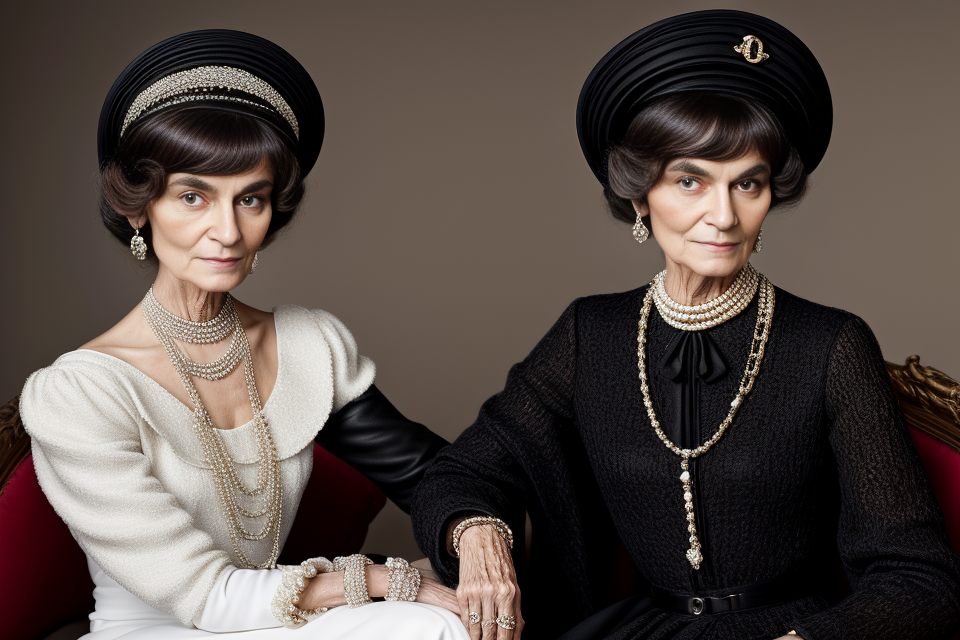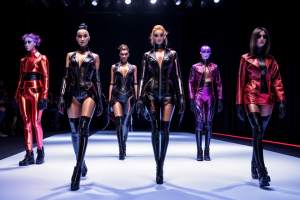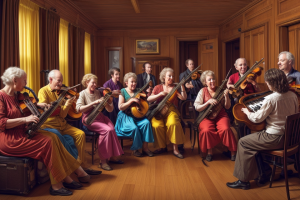
Fashion designers have always been a vital part of the fashion industry. They have been creating stunning pieces of clothing that have not only been aesthetically pleasing but also functional. But, among all the fashion designers, who is the most influential of all time? This is a question that has been debated for years. Some people believe that Coco Chanel is the most influential fashion designer, while others argue that it is Karl Lagerfeld. In this article, we will explore the lives and careers of both designers and try to determine who is the most influential fashion designer of all time. So, let’s dive in and find out!
It is difficult to determine who the most influential fashion designer of all time is, as there have been so many talented and innovative designers throughout history. However, if we consider the impact that a designer has had on the fashion industry and popular culture, then it is hard to overlook the contributions of Coco Chanel. Chanel was a pioneering designer who introduced the little black dress, the tweed suit, and the iconic Chanel No. 5 perfume to the world. Her designs were characterized by their simplicity, elegance, and practicality, and she was known for challenging traditional fashion norms and expectations. Chanel’s influence extends far beyond the world of fashion, and she remains one of the most celebrated and enduring figures in the history of the industry.
Revolutionizing Fashion
Coco Chanel
Innovative Designs
Coco Chanel’s impact on the fashion industry is immeasurable. She was a visionary who consistently challenged traditional norms and pushed the boundaries of fashion design. One of her most significant contributions was her emphasis on practicality and comfort in women’s clothing. Chanel believed that fashion should be functional and not just aesthetically pleasing. She wanted women to feel confident and comfortable in their clothing, and this philosophy is evident in her designs.
The Little Black Dress
One of Chanel’s most iconic designs is the little black dress. This simple yet elegant garment has become a staple in every woman’s wardrobe. Chanel’s design was revolutionary because it challenged the idea that women should only wear dresses in pastel colors. The little black dress was a bold statement, and it empowered women to embrace their femininity in a new way.
The Chanel Suit
Another iconic design by Chanel is the Chanel suit. This classic garment consists of a collarless jacket and a skirt that hits just above the knee. The Chanel suit was designed to be practical and comfortable, and it quickly became a popular choice for women in the workplace. Chanel’s design was innovative because it combined masculine and feminine elements, creating a unique and modern look.
Breaking Barriers
Chanel was also a trailblazer in terms of breaking barriers in the fashion industry. She was a strong advocate for women’s empowerment and believed that women should be able to express themselves through their clothing. Chanel’s designs were often inspired by menswear, and she was not afraid to challenge traditional gender norms.
Women’s Empowerment
Chanel’s designs were not just about aesthetics; they were also about empowering women. She believed that women should be able to express themselves through their clothing, and she designed garments that allowed women to do just that. Chanel’s designs were often inspired by menswear, and she was not afraid to challenge traditional gender norms.
High Fashion for Everyday Wear
Chanel was also a pioneer in the concept of high fashion for everyday wear. She believed that fashion should be accessible to everyone, and she designed garments that were both stylish and practical. Chanel’s designs were often inspired by the clothes that she saw women wearing on the streets, and she believed that fashion should be a reflection of real life.
Yves Saint Laurent
Fashion Revolution
Yves Saint Laurent was a French fashion designer who revolutionized the fashion industry with his innovative designs and daring ideas. He was one of the first designers to break away from the traditional fashion norms and bring a new sense of style and elegance to the world of fashion.
Mondrian Dress
One of Saint Laurent’s most iconic designs was the Mondrian dress, which he created in 1965. The dress was inspired by the paintings of Piet Mondrian, and it featured a bold, color-blocked design with vertical and horizontal lines. The dress was a departure from the flowing, billowing dresses that were popular at the time, and it represented a new, more modern approach to fashion.
Safety Pins Dress
Another one of Saint Laurent’s iconic designs was the safety pins dress, which he created in 1971. The dress was made of black wool and featured thousands of safety pins that were arranged in a random pattern. The dress was a response to the violent protests and social unrest that were happening at the time, and it represented a new, more political approach to fashion.
Redefining Women’s Roles
Saint Laurent’s designs were not just about fashion; they were also about empowering women. He believed that fashion could be a powerful tool for women to express themselves and redefine their roles in society.
Working Women’s Wardrobe
Saint Laurent was one of the first designers to create a working women’s wardrobe, which consisted of practical, stylish clothes that were suitable for the office. He believed that women should be able to look professional and stylish at the same time, and his designs reflected this philosophy.
Women in Power Dressing
Saint Laurent was also a pioneer of the power dressing trend, which was popular in the 1980s. He created a range of suits and dresses that were designed to make women feel confident and powerful, and his designs were worn by some of the most powerful women in the world, including Hillary Clinton and Margaret Thatcher.
Overall, Yves Saint Laurent was a true revolutionary in the world of fashion, and his designs continue to inspire and influence fashion designers and fashion lovers around the world.
Karl Lagerfeld
Creative Genius
Karl Lagerfeld, the iconic German fashion designer, has left an indelible mark on the fashion industry with his creative genius. His unique design philosophy and innovative approach to fashion have redefined the industry and continue to inspire designers around the world.
Haute Couture Reinvented
Lagerfeld’s reinvention of haute couture was nothing short of revolutionary. He brought a modern, edgy sensibility to the traditional art of French couture, making it more accessible and relevant to contemporary audiences. His designs were characterized by their bold, avant-garde silhouettes, dramatic volume, and exquisite attention to detail.
Fast Fashion Implementations
Lagerfeld was also a pioneer in implementing fast fashion principles, which allowed him to create and produce collections at an unprecedented pace. This approach allowed him to stay ahead of the curve and consistently deliver fresh, innovative designs to the market.
Pop Culture Impact
Celebrity Endorsements
Lagerfeld’s designs have been embraced by some of the most influential celebrities of our time, further cementing his status as a fashion icon. From Hollywood stars to pop icons, Lagerfeld’s designs have been worn by everyone from Lady Gaga to Madonna, adding to his already impressive legacy.
Fashion Collaborations
Lagerfeld’s collaborations with other designers and brands have also been instrumental in shaping the fashion industry. His collaborations with H&M, for example, brought high-end fashion to the masses and introduced his designs to a whole new audience. These collaborations helped to democratize fashion and make it more accessible to people around the world.
Influence on Pop Culture
Coco Chanel, Yves Saint Laurent, and Karl Lagerfeld are some of the most influential fashion designers of all time. They revolutionized the fashion industry with their innovative designs and daring ideas, redefining women’s roles in society. They were also pioneers in implementing fast fashion principles, which allowed them to create and produce collections at an unprecedented pace. Their impact on pop culture, including their iconic costumes in film and their influence on music, cannot be overstated.
Impact on Film
Iconic Costumes
Marilyn Monroe’s “Seven Year Itch” Dress
The “Seven Year Itch” dress is an iconic costume that was designed by William Travilla for the 1955 film of the same name. The dress features a white dress with a pleated skirt and a fitted bodice, and is worn by Marilyn Monroe in the famous scene where she stands over a subway grate and her dress blows up around her. The dress has become an enduring symbol of Hollywood glamour and Monroe’s enduring allure.
Audrey Hepburn’s “Breakfast at Tiffany’s” Little Black Dress
The little black dress that Audrey Hepburn wore in the 1961 film “Breakfast at Tiffany’s” is another iconic costume that has become a symbol of Hollywood glamour. The dress, which was designed by Hubert de Givenchy, is a simple yet elegant little black dress with a sheath silhouette and a neckline that is adorned with a diamond pendant necklace. The dress has become an enduring symbol of chic sophistication and has been copied by designers all over the world.
Fashion in Film
“The Devil Wears Prada”
The 2006 film “The Devil Wears Prada” is a classic fashion film that explores the cutthroat world of fashion journalism. The film stars Meryl Streep as the fearsome editor-in-chief of a top fashion magazine, and Anne Hathaway as her ambitious but inexperienced assistant. The film features a wide range of high-end fashion brands and designers, and showcases the glamour and exclusivity of the fashion industry.
“Coco Before Chanel”
“Coco Before Chanel” is a 2009 biographical film that tells the story of Coco Chanel, one of the most influential fashion designers of the 20th century. The film explores Chanel’s early life and her rise to fame as a fashion designer, and features a range of period-appropriate costumes that reflect the changing fashion trends of the time. The film offers a fascinating glimpse into the world of haute couture and the creative process behind some of Chanel’s most iconic designs.
Impact on Music
Fashion and Music Videos
Fashion and music videos have long been intertwined, with many iconic designers collaborating with famous musicians to create visually stunning videos that capture the essence of both fashion and music. One such collaboration that stands out is the partnership between Madonna and fashion designer Jean-Paul Gaultier. In Madonna’s “Material Girl” video, she can be seen wearing several iconic Gaultier pieces, including a black lace corset and a pink conical bra.
Another example of a fashion and music video collaboration is Lady Gaga’s “Bad Romance.” In this video, Gaga can be seen wearing a number of outlandish and attention-grabbing outfits, including a black leather bustier and skirt, a white lace dress, and a metallic silver jumpsuit. These outfits were designed by Alexander McQueen, and they perfectly capture the edgy, avant-garde aesthetic that Gaga is known for.
Fashion in Music Concerts
Music concerts are another area where fashion and music intersect, with many musicians using their concerts as an opportunity to showcase their style and personal aesthetic. One such musician who is known for his iconic fashion choices is Michael Jackson. In his “Thriller” concerts, Jackson can be seen wearing a variety of dazzling outfits, including a glittering silver jacket and a black and red military-inspired coat.
Another musician who is known for her impeccable style is Beyoncé. In her “Formation” tour, Beyoncé can be seen wearing a number of bold and daring outfits, including a black leather catsuit with a dramatic fur coat, a gold metallic jumpsuit, and a pair of statement boots. These outfits were designed by a variety of designers, including Gucci, Balmain, and Givenchy, and they perfectly capture Beyoncé’s powerful and confident persona.
Overall, the impact of fashion on music is undeniable, with many iconic designers and musicians collaborating to create visually stunning videos and concerts that capture the essence of both fashion and music. From Madonna’s “Material Girl” to Beyoncé’s “Formation” tour, these collaborations have left a lasting impact on pop culture and continue to inspire new generations of fashion and music lovers.
The Future of Fashion
Sustainability and Social Responsibility
Environmental Impact
Fashion has always been an industry that heavily relies on natural resources, which can lead to a significant environmental impact. One of the ways that designers are working to mitigate this impact is through recycling and upcycling. This involves using previously used materials to create new clothing and accessories, reducing the need for new resources.
Another way that designers are working towards sustainability is by using eco-friendly materials. These materials are made from renewable resources or are biodegradable, reducing the environmental impact of the fashion industry. Examples of eco-friendly materials include organic cotton, bamboo, and recycled polyester.
Ethical Labor Practices
In addition to environmental sustainability, social responsibility is also an important aspect of the future of fashion. This includes ensuring fair wages and working conditions for garment workers, as well as promoting diversity and inclusion in the industry.
One way that designers are working towards ethical labor practices is by ensuring that their products are made in safe and healthy working environments. This includes providing fair wages and benefits to workers, as well as promoting safe working conditions.
Another way that designers are promoting social responsibility is by promoting diversity and inclusion in the industry. This includes using models of diverse backgrounds and sizes in fashion shows and advertising campaigns, as well as promoting inclusivity in the design process.
By prioritizing sustainability and social responsibility, fashion designers can help to create a more ethical and environmentally friendly industry for the future.
The Role of Technology
Digital Fashion
Virtual Runway Shows
The use of technology has revolutionized the fashion industry by allowing designers to showcase their collections in virtual runway shows. These shows have become an essential part of the fashion calendar, enabling designers to reach a wider audience and reduce their carbon footprint. With the pandemic accelerating the shift towards digital events, virtual runway shows have become the new normal, and designers are embracing the medium to showcase their creativity and innovation.
3D Printing and Customization
3D printing technology has enabled fashion designers to create intricate designs and patterns that were previously impossible to produce. With 3D printing, designers can create customized pieces that fit perfectly and meet the unique needs of each customer. This technology has also opened up new possibilities for sustainable fashion, as it allows designers to create products on-demand and reduce waste.
AI in Fashion
Predictive Analytics for Trends
Artificial intelligence (AI) is being used in the fashion industry to predict trends and identify consumer preferences. By analyzing data from social media, fashion blogs, and other sources, AI algorithms can identify emerging trends and help designers create products that meet consumer demand. This technology has the potential to revolutionize the fashion industry by enabling designers to create products that are tailored to individual preferences and trends.
Personalized Shopping Experiences
AI is also being used to create personalized shopping experiences for customers. By analyzing data on customer preferences and purchase history, AI algorithms can recommend products that are tailored to each individual’s needs. This technology has the potential to enhance the customer experience and increase sales for fashion brands.
Overall, the role of technology in the fashion industry is rapidly evolving, and designers are embracing new technologies to stay ahead of the curve. With the rise of digital fashion, 3D printing, and AI, the fashion industry is poised for a technological revolution that will transform the way we create, consume, and experience fashion.
The Impact of Influential Fashion Designers
Transforming the Industry
In the world of fashion, influential designers have played a pivotal role in shaping the industry’s landscape. These visionaries have not only left an indelible mark on global fashion trends but have also revolutionized business models, challenging traditional norms and redefining the way fashion is perceived and consumed.
Shaping Global Fashion Trends
The most influential fashion designers have the power to dictate global fashion trends, which in turn have a profound impact on society. Through their unique design aesthetics and innovative approaches, these designers have consistently set the standard for fashion, influencing everything from haute couture to high street fashion. By pushing the boundaries of fashion, they have inspired countless designers and shaped the direction of the industry.
Revolutionizing Fashion Business Models
In addition to shaping global fashion trends, influential fashion designers have also revolutionized business models within the industry. They have challenged traditional retail practices, embraced new technologies, and explored alternative distribution channels. By doing so, they have created a ripple effect that has transformed the way fashion brands operate, with many now adopting more sustainable and ethical practices.
Inspiring Future Designers
The impact of influential fashion designers extends beyond the industry itself, inspiring future generations of designers to pursue their dreams and push the boundaries of fashion. These visionaries have left a legacy of innovation, inspiring designers to think outside the box and challenge conventional norms. Through their groundbreaking designs and trailblazing approaches, they have empowered future designers to continue the revolution and shape the future of fashion.
In conclusion, the most influential fashion designers have left an indelible mark on the industry, shaping global fashion trends, revolutionizing business models, and inspiring future generations of designers. Their legacy continues to inspire and influence the world of fashion, shaping its future and ensuring that their vision and creativity will endure for years to come.
FAQs
1. Who is the most influential fashion designer of all time?
The most influential fashion designer of all time is a matter of debate, but many experts consider Coco Chanel to be the most influential. She was a pioneer in the fashion industry and introduced many innovative designs that are still popular today.
2. What made Coco Chanel so influential?
Coco Chanel was influential because she was a true innovator in the fashion industry. She introduced the concept of the little black dress, which became a staple of women’s wardrobes worldwide. She also popularized the use of jersey knit in fashion, and her designs were characterized by their simplicity and elegance.
3. Was Coco Chanel the only influential fashion designer?
No, there have been many other influential fashion designers throughout history. Other notable designers include Christian Dior, who popularized the “New Look” in the 1940s and 1950s, and Gianni Versace, who was known for his bold and daring designs. Yves Saint Laurent was also a major influence, known for his innovative designs and use of different fabrics.
4. What was Coco Chanel’s impact on fashion?
Coco Chanel’s impact on fashion was significant. She was one of the first designers to emphasize comfort and practicality in fashion, and her designs were characterized by their simplicity and elegance. She also introduced the concept of the designer label, and her brand became synonymous with luxury and style.
5. Are there any contemporary fashion designers who are influential?
Yes, there are many contemporary fashion designers who are influential. Some of the most notable names include Karl Lagerfeld, Marc Jacobs, and Tom Ford. These designers have all made significant contributions to the fashion industry and continue to be influential figures today.







